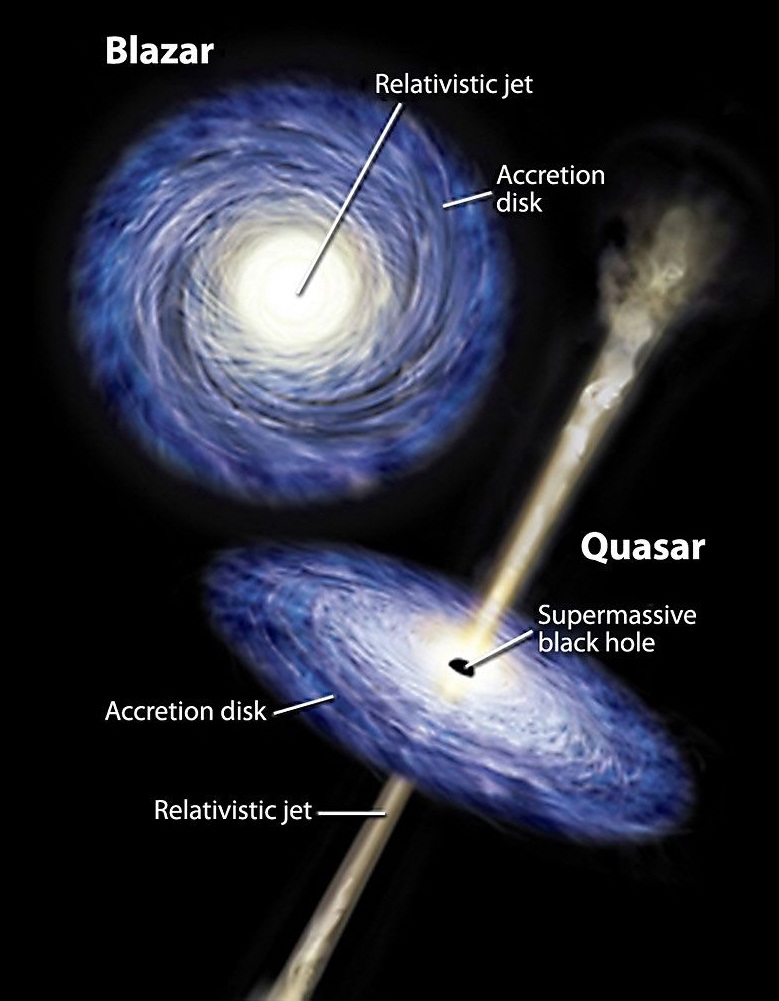Gamma-ray Flux Variability of Blazars | 20 Apr 2020
Why in News
Researchers from the Indian Institute of Astrophysics (IIA), Bangalore have conducted the first systematic study on the gamma-ray flux variability nature of different types of blazars.
- The research work based on characterizing the flux variability nature on month-like time scales in the high energy gamma-ray (100 MeV to 300 GeV) band for different types of blazars has been published in the journal Astronomy and Astrophysics.
- IIA is an autonomous institute of the Department of Science and Technology, Government of India.
Blazars
- Blazars are active galactic nuclei (AGN), whose jets are aligned with the observer’s line of sight. Some blazars are thought to host binary black holes in them and could be potential targets for future gravitational-wave searches.
- Active Galactic Nuclei:
- At the center of most galaxies, there’s a massive black hole with a huge mass accumulating gas, dust, and stellar debris around it. AGN is formed when the gravitational energy of these materials, being pulled towards the black hole, is converted into light.
- A minority of AGN (~15%) emits collimated charged particles called jets travelling at speeds close to the speed of light.
- Quasar and Radio-Galaxies are also AGN.
- The difference between Quasar, radio galaxy and a Blazar is the angle of the stream/jet. If the stream is straight up, it is a radio galaxy and the observer is not in the firing line. If the stream is angled slightly towards the observer, then it is a Quasar and if the stream is angled directly towards the observer, it is a Blazar.
- Active Galactic Nuclei:
- Blazars are the most luminous and energetic objects in the known universe and they were found to be emitters of gamma-rays in the 1990s.
- The flux variability characteristics of blazars on a range of time scales was found out with the help of Fermi Gamma-ray space telescope (launched in 2008) which is capable of scanning the entire sky once in three hours.
- Study by Indian Institute of Astrophysics:
- The research characterised the amplitude and time scale of flux variations and then looked for similarity and/or differences in the amplitude and time scale between different types of blazars.
- With the availability of near-simultaneous data covering the gamma-ray, X-ray, ultra-violet, optical, and infrared bands, the existing notion on high energy emission in blazars is challenged.
- The reduction of large volumes of data for a large number of sources was accomplished by the use of the High-Performance Computing facility of the IIA.
- The research characterised the amplitude and time scale of flux variations and then looked for similarity and/or differences in the amplitude and time scale between different types of blazars.
Significance of the Study
- The study can provide clues to the processes happening close to the black hole which are not visible through direct imaging. It will also enhance the knowledge of blazars.
- Exploring the Gamma-ray band of the electromagnetic spectrum will provide key inputs to constrain the high energy production site as well as the high energy emission processes.
- The results of this work will fill the gap on the knowledge of the high energy flux variability nature of blazars.
- Gamma-ray band is one of the bands of the electromagnetic spectrum on which there is limited knowledge on the flux variability of blazars.
- Localizing the site for the production of gamma-rays is one of the major problems in high energy astrophysics.
- The expertise of handling high energy data from celestial sources gained in this work will build capacity to interpret the gamma-ray data that will emerge from India's upcoming facility, the Major Atmospheric Cerenkov Experiment (MACE) Telescope as well as from any X-ray missions by India in the future.
Major Atmospheric Cerenkov Experiment Telescope
- It is the India's largest and the world's highest gamma-ray telescope being established at Hanle, Ladakh.
- It is being built by the Electronics Corporation of India Limited (ECIL), Hyderabad for the Bhabha Atomic Research Centre (BARC).
- It is remotely operated and runs on Solar Power.
- It will help to explore the exciting energy range of the gamma-ray energy region in between satellites and the traditional Atmospheric Cerenkov experiments.
- The telescope is named after the Russian scientist Cerenkov who predicted that charged particles moving at high speeds in a medium, emit light.

